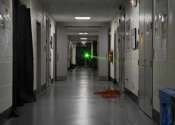Scientists create never-before-seen form of matter
Harvard and MIT scientists are challenging the conventional wisdom about light, and they didn't need to go to a galaxy far, far away to do it.

Harvard and MIT scientists are challenging the conventional wisdom about light, and they didn't need to go to a galaxy far, far away to do it.
Quantum Physics
Sep 25, 2013
139
12

A team of researchers affiliated with multiple institutions in the U.S., working with a colleague from France and another from Guatemala, has discovered a very large 2,000-year-old Mayan civilization in northern Guatemala. ...

One of the enduring sci-fi moments of the big screen—R2-D2 beaming a 3-D image of Princess Leia into thin air in "Star Wars"—is closer to reality thanks to the smallest of screens: dust-like particles.
Optics & Photonics
Jan 24, 2018
5
2385

Any science textbook will tell you we can't see infrared light. Like X-rays and radio waves, infrared light waves are outside the visual spectrum. But an international team of researchers co-led by scientists at Washington ...
Other
Dec 1, 2014
21
2

Researchers from the University of Bonn have just shown how a single atom can be split into its two halves, pulled apart and put back together again. While the word "atom" literally means "indivisible," the laws of quantum ...
General Physics
Jun 5, 2012
12
0

A device resembling a plastic honeycomb yet infinitely smaller than a bee's stinger can steer light beams around tighter curves than ever before possible, while keeping the integrity and intensity of the beam intact.
Optics & Photonics
Mar 19, 2015
5
385

Most objects react in predictable ways when force is applied to them—unless they have "negative mass." And then they react exactly opposite from what you would expect.
Optics & Photonics
Jan 10, 2018
52
6028

More luminous and energy efficient than LEDs, white lasers look to be the future in lighting and light-based wireless communication.
Optics & Photonics
Jul 29, 2015
9
8615

The University of Rochester research lab that recently used lasers to create unsinkable metallic structures has now demonstrated how the same technology could be used to create highly efficient solar power generators.
Optics & Photonics
Feb 4, 2020
2
5513

It's not at every university that laser pulses powerful enough to burn paper and skin are sent blazing down a hallway. But that's what happened in UMD's Energy Research Facility, an unremarkable looking building on the northeast ...
Optics & Photonics
Jan 19, 2023
3
637
A laser is a device that emits light (electromagnetic radiation) through a process called stimulated emission. The term laser is an acronym for light amplification by stimulated emission of radiation. Laser light is usually spatially coherent, which means that the light either is emitted in a narrow, low-divergence beam, or can be converted into one with the help of optical components such as lenses. Typically, lasers are thought of as emitting light with a narrow wavelength spectrum ("monochromatic" light). This is not true of all lasers, however: some emit light with a broad spectrum, while others emit light at multiple distinct wavelengths simultaneously. The coherence of typical laser emission is distinctive. Most other light sources emit incoherent light, which has a phase that varies randomly with time and position.
This text uses material from Wikipedia, licensed under CC BY-SA